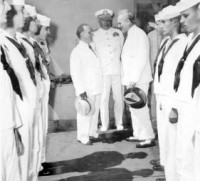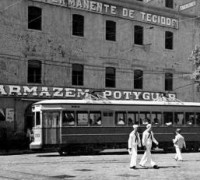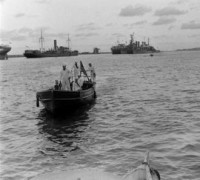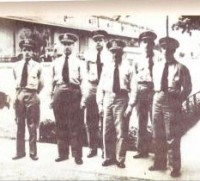MILITARY RELATIONS WITH BRAZIL BEFORE PEARL HARBOR - BRAZIL X USA MILITARY RELATIONS
7)PROBLEMS OF ARMS SUPPLY
General Goes Monteiro, in his talks with American staff officers during June and July 1939, took the position that
For this purpose he proposed the installation of coast defense and antiaircraft guns and construction of air and naval bases, and suggested that the base sites be selected jointly by American and Brazilian staff officers. These proposals hinged on the ability and willingness of the United States to supply Brazil with large quantities of arms and other war material and to grant technical and financial assistance in the construction of the proposed air and naval bases.
General Goes Monteiro informally submitted a list of the ordnance and air equipment
While the armaments request included air and naval items, the apparent implication of the Brazilian proposals was that if
In summarizing the Rio conversations for General Marshall, Major Ridgway of the War Plans Division concluded that the crucial factor in carrying out General Goes Monteiro's plan for defending
The difficulty was that legal restrictions prevented the United States Army from providing from its own stocks or arsenals the type of military material that
Major Ridgway could only urge that the arms supply question be considered, that the United States provide such technical assistance and training to Brazilian Army officers as might be practicable, and that, in the meantime, American plans for formation of a joint Army-Navy expeditionary force to be employed in defense of the Brazilian bulge in an emergency be developed with a minimum of delay.
The day before Germany invaded Poland, President Roosevelt and the Department of State became alarmed by reports that the Germans intended to seize the island of Fernando de Noronha, lying about 215 miles off the Brazilian coast, and turn it into a submarine base. Brazilian authorities assured the
Their request now received President Roosevelt's personal attention and backing.After the outbreak of the European war, the Brazilian Army was doubly anxious to get American arms, since it appeared probable that there would be great difficulty in securing deliveries on the Krupp order.
General Marshall in October explained to General Goes Monteiro the existing difficulties that prevented the United States Army from readily providing all the types of equipment
This flight, when undertaken in November under the leadership of General Headquarters Air Force commander General Emmons, provided the means not only for publicizing Brazilian-American friendship but also for furthering military collaboration. As previously mentioned, General Emmons and his party used this opportunity to conduct a careful survey of the west and east coast air routes to the Brazilian bulge, and of the Natal area on the bulge as the prospective major air base site.
General Marshall had arranged for Major Ridgway to accompany the flight, and he, together with Col. Allen Kimberly, Chief of the United States Military Mission, discussed problems of strategy and arms supply with General Goes Monteiro.
They offered the Brazilian Chief of Staff the surplus coast artillery weapons that the President had approved for sale and also gave him a list of strategic raw materials that the
The Brazilians agreed to this procedure and arranged for three of their artillery officers to return with General Emmons to inspect the material offered. The surplus coast defense equipment offered to
None of the material was in an immediately usable condition, but apparently neither Americans nor Brazilians foresaw the difficulties that lay ahead in getting the weapons ready for actual use. At the time, coast defense guns appear to have been considered an interim contribution that the United States Army could make immediately to
Between January and May 1940,
At General Marshall's urging, the War Department from the spring of 1940 onward seems to have done all that it could to expedite work on this equipment. In November 1940 the Chief of Staff arranged to attach Lt. Col. Morgan L. Brett, a retired ordnance expert, to the Brazilian Purchasing Commission in
The procurement of the 6-inch guns added nothing to the defenses of
The
When
The British in November 1940 seized a Brazilian vessel, the Siqueira Campos, that was attempting to carry some of these arms from
Finally, in the summer of 1941, the British permitted an American vessel to pick up a load of German arms (mostly missing parts for equipment already delivered) at
Again, the intervention of General Marshall in securing this permission was perhaps decisive. Throughout, the United States Army seems to have done all it could to help the Brazilian Army secure delivery on their German armament order. By November 1941
The failure of the United States, for whatever good reasons, to make effective delivery of the coast defense equipment purchased by the Brazilians in early 1940, together with the Brazilian Army's failure to get more than a fraction of the arms ordered from Germany before the war, introduced a factor of irritation in Brazilian-American military relations that made it increasingly difficult to plan for the defense of the Brazilian bulge.
Knowing that they could not obtain more than a small part of their German armaments order, the Brazilians realized that they must get large quantities of arms in the
On the other hand, until 1942 the
Transcribed by Patrick Clancey – Hyper War Foundation



